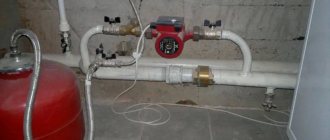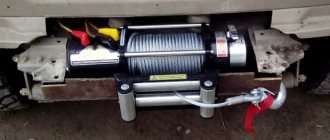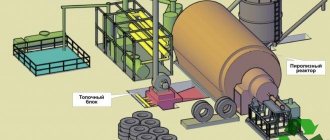Rising energy prices make us think about the possibility of providing ourselves with them ourselves. One option is a biogas plant. With its help, biogas is obtained from manure, droppings and plant residues, which, after purification, can be used for gas appliances (stoves, boilers), pumped into cylinders and used as fuel for cars or electric generators. In general, processing manure into biogas can meet all the energy needs of a home or farm.
Construction of a biogas plant is a way to independently provide energy resources
General principles
Biogas is a product that is obtained from the decomposition of organic substances. During the process of rotting/fermentation, gases are released, collecting which you can meet the needs of your own household. The equipment in which this process occurs is called a “biogas plant.”
In some cases, the gas output is excessive, then it is stored in gas tanks for use during periods of insufficient quantity. If the process is properly organized, there may be too much gas, then the excess can be sold. Fermented leftovers are another source of income. This is a highly effective and safe fertilizer - during the fermentation process, most microorganisms die, plant seeds lose their viability, and parasite eggs become unviable. Exporting such fertilizers to the fields has a positive effect on crop yields.
Conditions for gas production
The process of biogas formation occurs due to the vital activity of various kinds of bacteria that are contained in the waste itself. But in order for them to actively “work”, they need to create certain conditions: humidity and temperature. To create them, a biogas plant is being built. This is a complex of devices, the basis of which is a bioreactor, in which waste decomposition occurs, which is accompanied by gas formation.
Organization of a cycle for processing manure and plant waste into biogas
There are three modes for processing manure into biogas:
- Psychophilic mode. The temperature in the biogas plant is from +5°C to +20°C. Under such conditions, the decomposition process is slow, much gas is formed, and its quality is low.
- Mesophilic. The unit enters this mode at temperatures from +30°C to +40°C. In this case, mesophilic bacteria actively reproduce. In this case, more gas is formed, the processing process takes less time - from 10 to 20 days.
- Thermophilic. These bacteria multiply at temperatures from +50°C. The process goes the fastest (3-5 days), the gas output is the largest (under ideal conditions, with 1 kg of delivery you can get up to 4.5 liters of gas). Most reference tables for gas yield from processing are given specifically for this mode, so when using other modes it is worth making a smaller adjustment.
The most difficult thing to implement in biogas plants is the thermophilic mode. This requires high-quality thermal insulation of the biogas plant, heating and a temperature control system. But at the output we get the maximum amount of biogas. Another feature of thermophilic processing is the impossibility of additional loading. The remaining two modes - psychophilic and mesophilic - allow you to add a fresh portion of prepared raw materials daily. But, in the thermophilic mode, the short processing time makes it possible to divide the bioreactor into zones in which their share of raw materials will be processed with different loading times.
Design options
Device
Biogas, which is an environmentally friendly fuel, is produced in biogas plants, units that are a complex of technical structures and devices combined into a single technological cycle.
The configuration of a biogas plant can be different, depending on its power, the type of raw materials and the resulting final product in the form of thermal or electrical energy, both types of energy, or only biogas used in household gas stoves and as fuel for cars.
Standard installation consists of the following components and assemblies:
- A storage tank in which raw materials used to produce biogas are accumulated;
- Mixers and mills of various designs, dividing large fractions of raw materials into smaller ones;
- Gas holder, a hermetically sealed container that serves as a storage tank for the resulting gas;
- A reactor, container or reservoir in which the process of biofuel formation occurs;
- Systems for feeding raw materials into the reactor of the installation;
- A system for transferring the resulting fuel from the reactor and gas tank, further to the stages of processing and conversion into other types of energy;
- Automation systems, protection and control over the production processes of gas and its processed products.
The above diagram roughly shows the technological cycle of biogas production using liquid and solid raw materials, with its further processing and production of thermal and electrical energy.
With manual loading of raw materials, without heating and stirring
For domestic use, this model is considered the most convenient. With a reactor capacity of 1 to 10 m³, approximately 50–220 kg of manure will be needed daily. This is what you need to proceed from when deciding on the size of the container.
The installation is installed in the ground, so it will require a small pit. A location on the site is selected in accordance with its calculated dimensions. The composition and purpose of all elements of the circuit is not difficult to understand.
Installation feature
After installing the reactor on site, it is necessary to check its tightness. Then the metal must be painted (preferably with a frost-resistant composition) and insulated.
Recommendations:
- Removal of waste occurs naturally - either during the process of adding a new portion, or when there is an excess of gas in the reactor with the valve closed. Therefore, the capacity of the waste collection container should be no less than that of the working one.
- Despite the simplicity of the device and the attractiveness for do-it-yourself assembly, due to the fact that mixing and heating of the mass are not provided, this installation option is advisable to operate in regions with a mild climate, that is, mainly in the south of Russia. Although, with high-quality thermal insulation, in conditions where underground water layers are deep, this design is quite suitable for the middle zone.
Without heating, but with stirring
Almost the same thing, only a small modification that significantly increases the performance of the installation.
How to make a mechanism? For someone who assembled, for example, a concrete mixer based on a barrel with their own hands, this is not a problem. A shaft with blades will have to be mounted in the reactor. Therefore, it is necessary to install support bearings. It is good to use a chain as a transmission link between the shaft and the lever.
The biogas plant can be operated in almost all regions, with the exception of the northern regions. But unlike the previous model, it requires supervision.
Stirring + heating
The thermal effect on biomass increases the intensity of the decomposition and fermentation processes occurring in it. The biogas unit is more versatile in use, as it can operate in two modes - mesophilic and thermophilic, that is, in the temperature range (approximately) 25 - 65 ºС (see graphs above).
In the above diagram, the boiler runs on the resulting gas, although this is not the only option. Heating of biomass can be done in different ways, depending on how it is more convenient for the owner to organize it.
Automated options
The difference between this scheme is that a gas tank is connected to the installation. This allows you to accumulate gas reserves rather than using it immediately for its intended purpose. Ease of use is also due to the fact that almost any temperature regime is suitable for intensive fermentation.
This installation is even more productive. It is capable of processing up to 1.3 tons of raw materials per day with a similar reactor volume. Loading, mixing - pneumatics are responsible for this. The outlet channel allows waste to be removed either into a bunker for short-term storage, or into mobile containers for immediate removal. For example, for fertilizing fields.
These biogas plant options are hardly suitable for domestic use. Installing them, especially with your own hands, is much more difficult. But for a small farm it is a good solution.
Mechanized biogas plant
The difference from previous models is in the additional tank in which preliminary preparation of the raw material mass occurs.
Compressed biogas is fed into the loading hopper and then into the reactor. It is also used for heating.
The only thing that is necessary when assembling any of the installations with your own hands is accurate engineering calculations. You may need to consult a specialist. Otherwise everything is quite simple. If at least one of the readers becomes interested in a biogas unit and installs it themselves, then the author did not work on this article in vain. Good luck!
Biogas plant diagram
The basis of a biogas plant is a bioreactor or bunker. The fermentation process occurs in it, and the resulting gas accumulates in it. There is also a loading and unloading hopper; the generated gas is discharged through a pipe inserted into the upper part. Next comes the gas treatment system - cleaning it and increasing the pressure in the gas pipeline to working pressure.
Installation diagram for processing manure into biogas
For mesophilic and thermophilic modes, a bioreactor heating system is also required to reach the required modes. For this purpose, gas boilers running on produced fuel are usually used. From it, a pipeline system goes to the bioreactor. Usually these are polymer pipes, since they best withstand being in an aggressive environment.
A biogas plant also needs a system for mixing the substance. During fermentation, a hard crust forms at the top, and heavy particles settle down. All this together worsens the process of gas formation. Mixers are needed to maintain a homogeneous state of the processed mass. They can be mechanical or even manual. They can be started by timer or manually. It all depends on how the biogas plant is made. An automated system is more expensive to install, but requires a minimum of attention during operation.
The simplest biogas plant from a plastic barrel
According to the type of location, a biogas plant can be:
- Overground.
- Semi-recessed.
- Recessed.
Recessed ones are more expensive to install - a large amount of excavation work is required. But when used in our conditions, they are better - it is easier to organize insulation, and the heating costs are lower.
Factors influencing the fermentation process
The most significant factor in the fermentation of raw materials is the nature of the origin of the raw materials. Sugar pulp is considered such a product.
The efficiency of the fermentation process can be achieved by selecting bacterial groups that will “work” more actively, releasing biogas in large volumes.
The fermentation process is determined by the design features of the gas generator, equipping with mechanized equipment and electronic monitoring and control devices.
Temperature
Temperature is the main driver of the fermentation process. It is necessary to strictly follow the recommendations of experts in this matter. When using one type of raw material, it will be enough to heat it within 20-250C. Another type of biomass will require a heating level in the region of 400C.
All this must be taken into account during the operation of the installation. Each type of raw material will require its own groups of bacteria that actively “work” at a certain temperature.
Surface area of raw material particles
The rate of fermentation of the raw material depends on the surface area of the biomass. The smaller the area, the less bacterial activity. Their active zone is located in the surface layer of the raw material mass. Therefore, the frequency of its mixing depends on the volume of the feedstock.
Depending on the farm’s need for biogas and the type of bioactive raw material, the required reactor volume is calculated.
What can be recycled
A biogas plant is essentially omnivorous - any organic matter can be processed. Any manure and urine, plant residues are suitable. Detergents, antibiotics, and chemicals negatively affect the process. It is advisable to minimize their intake, as they kill the flora that processes them.
How much biogas can be obtained from various wastes?
Cattle manure is considered ideal, since it contains large quantities of microorganisms. If there are no cows on the farm, when loading the bioreactor, it is advisable to add some of the manure to populate the substrate with the required microflora. Plant residues are pre-crushed and diluted with water. Plant materials and excrement are mixed in a bioreactor. This “filling” takes longer to process, but at the end, under the correct mode, we have the highest product yield.
Uniqueness
Our production uses an innovative approach to producing biofuel: first, the raw material (algae biomass) for its production is synthesized, then the oil is pressed, from which biodiesel fuel is produced using proven technology. This fundamentally new approach to producing biofuel from non-food raw materials has a number of advantages compared to the production of bioenergy from vegetable oils. The main advantage of such production is its independence from the yield of oilseeds and their cost (rapeseed and other oils used as the main raw material for the production of biodiesel), the price of which increases with the increase in biofuel production.
Consumer
We plan to work according to the B2B scheme and, ideally, we will sell the full volume of biodiesel production to one interested company. These companies may include companies involved in:
· rail and road transportation
· oil sales
· agro-industrial companies
Organization
The commercial organization ZAO BioEnergoRoss is aimed at producing biodiesel fuel. The management team is also the founders of the organization. The investor will be given a portion of the company's shares corresponding to the invested funds.
Marketing
Goods
produces the main product - biodiesel, and two by-products - glycerin and a food additive for cattle and pigs (algae cake).
Location determination
To minimize the costs of organizing the process, it makes sense to locate the biogas plant close to the source of waste - near buildings where poultry or animals are kept. It is advisable to develop the design so that loading occurs by gravity. From a barn or pigsty, you can lay a pipeline at a slope through which manure will flow by gravity into the bunker. This greatly simplifies the task of maintaining the reactor, and also removing manure.
It is most advisable to locate the biogas plant so that waste from the farm can flow by gravity
Typically, buildings with animals are located at some distance from a residential building. Therefore, the generated gas will need to be transferred to consumers. But laying one gas pipe is cheaper and easier than organizing a line for transporting and loading manure.
Usage
Biofuel is most often used for domestic purposes for:
- heating a home or farm;
- heating water for domestic needs.
It is not advisable to use this fuel option for cooking, since the specific smell can be absorbed by food, and the food will have an unpleasant aftertaste.
As you can see, the manufacturing process of the installation is quite simple. Save and always be warm, regardless of energy prices. In this case, the labor costs are justified.
Bioreactor
There are quite strict requirements for manure processing tanks:
- It must be impermeable to water and gases. Water resistance should work in both directions: the liquid from the bioreactor should not pollute the soil, and groundwater should not change the state of the fermented mass.
- The bioreactor must have high strength. It must withstand the mass of the semi-liquid substrate, the gas pressure inside the container, and the soil pressure acting outside. In general, when constructing a bioreactor, special attention must be paid to its strength.
For home use and seasonal production of biofuel (during the warm season) in small volumes, a plastic tank with a lid is suitable - Ease of maintenance. Cylindrical containers are more convenient to use - horizontal or vertical. In them, mixing can be organized throughout the entire volume; stagnant zones do not form in them. Rectangular containers are easier to implement when building with your own hands, but cracks often form in their corners, and the substrate stagnates there. Stirring it in the corners is very problematic.
All these requirements for the construction of a biogas plant must be met, as they ensure safety and create normal conditions for processing manure into biogas.
What materials can it be made from?
Resistance to aggressive environments is the main requirement for materials from which containers can be made. The substrate in the bioreactor can be acidic or alkaline. Accordingly, the material from which the container is made must tolerate various environments well.
Not many materials meet these requests. The first thing that comes to mind is metal. It is durable and can be used to make containers of any shape. The good thing is that you can use a ready-made container - some old tank. In this case, the construction of a biogas plant will take very little time. The disadvantage of metal is that it reacts with chemically active substances and begins to collapse. To neutralize this disadvantage, the metal is coated with a protective coating.
An excellent option is a bioreactor container made of polymer. Plastic is chemically neutral, does not rot, does not rust. You just need to choose from materials that can withstand freezing and heating to fairly high temperatures. The reactor walls should be thick, preferably glass fiber reinforced. Such containers are not cheap, but they last a long time.
It is possible to build a bioreactor for the production of biogas from brick, but it must be well plastered using additives that ensure water and gas impermeability
A cheaper option is a biogas plant with a container made of bricks, concrete blocks, or stone. In order for the masonry to withstand high loads, it is necessary to reinforce the masonry (in every 3-5 rows, depending on the thickness of the wall and the material). After completing the wall construction process, to ensure water and gas impermeability, subsequent multi-layer treatment of the walls is necessary both inside and outside. The walls are plastered with a cement-sand composition with additives (additives) that provide the required properties.
Reactor sizing
The reactor volume depends on the selected temperature for processing manure into biogas. Most often, mesophilic is chosen - it is easier to maintain and it allows for the possibility of daily reloading of the reactor. Biogas production after reaching normal mode (about 2 days) is stable, without surges or dips (when normal conditions are created). In this case, it makes sense to calculate the volume of the biogas plant depending on the amount of manure generated on the farm per day. Everything is easily calculated based on average statistical data.
| Animal breed | Volume of excrement per day | Initial humidity |
| Cattle | 55 kg | 86% |
| Pig | 4.5 kg | 86% |
| Chickens | 0.17 kg | 75% |
The decomposition of manure at mesophilic temperatures takes from 10 to 20 days. Accordingly, the volume is calculated by multiplying by 10 or 20. When calculating, it is necessary to take into account the amount of water that is necessary to bring the substrate to an ideal state - its humidity should be 85-90%. The found volume is increased by 50%, since the maximum load should not exceed 2/3 of the tank volume - gas should accumulate under the ceiling.
For example, there are 5 cows, 10 pigs and 40 chickens on a farm. The result is 5 * 55 kg + 10 * 4.5 kg + 40 * 0.17 kg = 275 kg + 45 kg + 6.8 kg = 326.8 kg. To bring chicken manure to 85% humidity, you need to add a little more than 5 liters of water (that’s another 5 kg). The total weight is 331.8 kg. For processing in 20 days you need: 331.8 kg * 20 = 6636 kg - about 7 cubic meters only for the substrate. We multiply the found figure by 1.5 (increase by 50%), we get 10.5 cubic meters. This will be the calculated value of the reactor volume of the biogas plant.
Optional equipment
Additional equipment, without which the operation of the bioreactor is impossible, includes:
- grinding device;
- source of thermal energy;
- process water discharge system;
- sapropel storage;
- treatment plant;
- main gas tank;
- gas liquefaction plant;
- gas holder for liquefied gas;
- control system.
Grinding device
The grinding device receives manure/liquid from animal/poultry areas , as well as litter washed away or manually removed, and crushes all large fragments to facilitate the work of bacteria.
In addition, the grinding device mixes the crushed mass with water to provide the required level of humidity, and during mixing the material is further crushed.
Such crushed and diluted material with water is called a substrate.
After preparation, the substrate enters the digester through pipes and is mixed with the substance contained in it.
Thermal energy source
Most often, the role of such a source is played by a gas boiler adapted for operation on methane, which also supplies the heating system with heat in winter.
The advantage of a methane boiler is the ability to connect to the main gas tank, which makes it possible to do without the use of additional energy resources.
In this case, it is necessary to constantly monitor the temperature inside the bioreactor so that it is always within optimal limits and, if necessary, increase or decrease the gas supply, for which temperature sensors are installed inside the container .
Process water discharge system
The process water drained from the bioreactor contains some organic and inorganic substances, but it does not contain pathogens, eggs or larvae of worms, or weed seeds. Therefore, it can be used for watering, as well as for diluting compositions used for fertilizing.
To realize all these possibilities, the system, in addition to a periodically opened drain valve, must contain a container for process water and means of delivery to the point of use.
Sapropel storage
The sapropel that accumulates at the bottom of the digester enters the storage facility through a special valve, where it gradually accumulates.
It is a good fertilizer, comparable to humus, but loosens the soil less efficiently.
However, sapropel effectively replaces many complex fertilizers , because it contains a wide range of organic and inorganic substances.
Once filled, the storage facility is opened and the collected material is removed from it, which is then applied to the soil.
Cleaning device
Biogas consists of methane (50–60%) and other gases, therefore, in its unpurified state, it has low calorific value.
The purification plant removes carbon dioxide and hydrogen sulfide from it, making the share of methane 94–97%.
Such purified biogas is comparable in its calorific value to natural and liquefied gas , so it can be used as fuel for any devices that initially operate on these types of fuel.
Main gas tank
This equipment is necessary to smooth out gas pressure differences during connection or disconnection of consumers. The gas tank is made of steel, thanks to which it can withstand pressure of tens or hundreds of atmospheres.
A pump also works together with the gas tank, pumping gas into it at the required pressure.
Gas liquefaction apparatus and gas holder for its storage
This installation allows gas to be stored during periods when consumption is less than production. The fact is that liquefied gas takes up much less space, so with the same storage volume you can store much more of it.
The device liquefies the gas using cooling , causing it to change from a gaseous to a liquid state.
A gas holder for liquefied gas is made of high-strength steel and is also carefully insulated, because the pressure inside the gas holder depends not only on the amount of liquefied methane, but also on its temperature.
Such a gas tank allows you to make a supply of liquefied methane in the summer months, which in winter can be used for heating or other needs, compensating for the insufficient production of biogas. In addition, liquefied gas from a gas tank is well suited for refueling cars and other equipment that runs on this type of fuel.
Control system
To ensure maximum biogas production, as well as to increase the proportion of methane in it, it is necessary not only to maintain the optimal temperature, but also to perform all necessary actions in a timely manner, that is:
- supply substrate;
- drain water;
- remove sapropel;
- regulate the operation of treatment and liquefaction plants.
All these actions are performed by the control system , which consists of a central server and various peripheral devices.
In addition, it is connected to sensors that monitor the status and performance of all devices included in it.
Loading and Unloading
Loading and unloading hatches lead directly into the bioreactor tank. In order for the substrate to be evenly distributed over the entire area, they are made at opposite ends of the container.
Diagram of a biogas reactor without half-heating
When installing a biogas plant in-depth, the loading and unloading pipes approach the body at an acute angle. Moreover, the lower end of the pipe should be below the liquid level in the reactor. This prevents air from entering the container. Also, rotary or shut-off valves are installed on the pipes, which are closed in the normal position. They open only during loading or unloading.
Since manure may contain large fragments (litter elements, grass stems, etc.), small diameter pipes will often become clogged. Therefore, for loading and unloading, they must have a diameter of 20-30 cm. They must be installed before the start of work on insulating the biogas plant, but after the container is installed in place.
Bioreactor shapes and options for loading and unloading hatches
The most convenient mode of operation of a biogas plant is with regular loading and unloading of the substrate. This operation can be performed once a day or once every two days. Manure and other components are preliminarily collected in a storage tank, where they are brought to the required state - crushed, if necessary, moistened and mixed. For convenience, this container may have a mechanical stirrer. The prepared substrate is poured into the receiving hatch. If you place the receiving container in the sun, the substrate will be preheated, which will reduce the cost of maintaining the required temperature.
It is advisable to calculate the installation depth of the receiving hopper so that waste flows into it by gravity. The same applies to unloading into the bioreactor. The best case is if the prepared substrate moves by gravity. And a shutter will fence it off during preparation.
Biogas plant with stirrer and heating
To ensure the tightness of the biogas plant, the hatches on the receiving hopper and in the unloading area must have a sealing rubber seal. The less air there is in the container, the cleaner the gas will be at the outlet.
Legal registration
The installation will have to be coordinated with the SES, gas inspectorate and firefighters. You will need:
- Technological diagram of the installation.
- Layout plan for equipment and components with reference to the installation itself, the installation location of the thermal unit, the location of pipelines and energy mains, and pump connections. The diagram should indicate the lightning rod and access roads.
- If the installation will be located indoors, then a ventilation plan will also be required, which will provide at least an eightfold exchange of all the air in the room.
As we see, we cannot do without bureaucracy here.
Having a source of energy is a sin not to use it
Finally, a little about the performance of the installation. On average, per day a biogas plant produces a volume of gas twice the useful volume of the reservoir. That is, 40 m3 of slurry will produce 80 m3 of gas per day. Approximately 30% will be spent on ensuring the process itself (the main expense item is heating). Those. at the output you will receive 56 m3 of biogas per day. According to statistics, to cover the needs of a family of three and to heat an average-sized house, 10 m3 is required. In net balance you have 46 m3 per day. And this is with a small installation.
Collection and removal of biogas
Biogas is removed from the reactor through a pipe, one end of which is under the roof, the other is usually lowered into a water seal. This is a container with water into which the resulting biogas is discharged. There is a second pipe in the water seal - it is located above the liquid level. Cleaner biogas comes out into it. A gas shut-off valve is installed at the outlet of their bioreactor. The best option is a ball one.
What materials can be used for the gas transmission system? Galvanized metal pipes and gas pipes made of HDPE or PPR. They must ensure tightness; seams and joints are checked using soap foam. The entire pipeline is assembled from pipes and fittings of the same diameter. No contractions or expansions.
Cleansing from impurities
The approximate composition of the resulting biogas is:
Approximate composition of biogas
- methane - up to 60%;
- carbon dioxide - 35%;
- other gaseous substances (including hydrogen sulfide, which gives the gas an unpleasant odor) - 5%.
In order for biogas to be odorless and burn well, it is necessary to remove carbon dioxide, hydrogen sulfide, and water vapor from it. Carbon dioxide is removed in a water seal if slaked lime is added to the bottom of the installation. Such a bookmark will have to be changed periodically (as soon as the gas starts to burn worse, it’s time to change it).
Gas drying can be done in two ways - by making water seals in the gas pipeline - by inserting curved sections into the pipe under the water seals, in which condensate will accumulate. The disadvantage of this method is the need to regularly empty the water seal - if there is a large amount of collected water, it can block the passage of gas.
The second way is to install a filter with silica gel. The principle is the same as in a water seal - the gas is supplied to the silica gel, and dried out from under the lid. With this method of drying biogas, the silica gel must be dried periodically. To do this, you need to warm it up in the microwave for some time. It heats up and the moisture evaporates. You can fill it up and use it again.
Filter for cleaning biogas from hydrogen sulfide
To remove hydrogen sulfide, a filter loaded with metal shavings is used. You can load old metal scourers into the container. Purification occurs in exactly the same way: gas is supplied to the lower part of the container filled with metal. As it passes, it is cleared of hydrogen sulfide, collected in the upper free part of the filter, from where it is discharged through another pipe/hose.
Gas tank and compressor
The purified biogas enters a storage tank - a gas holder. This can be a sealed plastic bag or plastic container. The main condition is gas tightness; shape and material do not matter. The gas holder stores a supply of biogas. From it, with the help of a compressor, gas under a certain pressure (set by the compressor) is supplied to the consumer - to the gas stove or boiler. This gas can also be used to generate electricity using a generator.
One of the gas tank options
To create stable pressure in the system after the compressor, it is advisable to install a receiver - a small device for leveling pressure surges.
Advantages of biodiesel over petroleum diesel
Biodiesel does not pollute the planet.
If we are talking about buying ready-made fuel, then from an economic point of view, ordinary diesel fuel, which is made from oil, will be more profitable, since it is cheaper. If you make biodiesel at home from purchased oil, it is also expensive. The only option when it is profitable to produce biofuel is to have your own oil. If this is not the case, buy regular diesel fuel and heat it with it.
Strengths of using biofuels to heat your home:
- it is much safer to store energy reserves - the ignition temperature is 100 degrees, while ordinary diesel fuel ignites at 60 degrees;
- biodiesel does not pollute nature, minimal sulfur content;
- Biodiesel emits little carbon dioxide.
The fact that it is safer to store biofuels is good, but not everything is ideal here either. After three months, biodiesel begins to break down into its component parts, and this imposes some restrictions.
Mixing devices
In order for the biogas plant to operate normally, it is necessary to regularly mix the liquid in the bioreactor. This simple process solves many problems:
- mixes a fresh portion of the load with a colony of bacteria;
- promotes the release of produced gas;
- equalizes the temperature of the liquid, excluding warmer and colder areas;
- maintains the homogeneity of the substrate, preventing the settling or floating of some components.
Typically, a small homemade biogas plant has mechanical agitators that are driven by muscle power. In large-volume systems, the agitators can be driven by motors that are activated by a timer.
Types of stirrers for bioreactors
The second method is to stir the liquid by passing some of the generated gas through it. To do this, after exiting the metatank, a tee is installed and part of the gas flows into the lower part of the reactor, where it exits through a tube with holes. This part of the gas cannot be considered a consumption, since it still enters the system again and, as a result, ends up in the gas tank.
The third method of mixing is to use fecal pumps to pump the substrate from the lower part and pour it at the top. The disadvantage of this method is its dependence on the availability of electricity.
Autonomous gasification - gas holder
In recent years, a solution to the problem of energy supply for a country house has appeared on the market of gas equipment for domestic use. This is autonomous gasification. And first of all, we are talking about installing gas tanks or gas holders. The principle of using a gas tank is to periodically fill its volume with liquefied natural gas. Today there are many companies offering services for delivering LNG by specialized tank trucks and filling the gas into the tank. Depending on the volume, you can forget about its maintenance for 3-6 months, and use household gas appliances to the fullest, without thinking about economical consumption.
Non-conventional energy sources include biogas, which is produced in special installations and used to produce various types of energy used by humans in everyday life (heat, electricity and fuel for cars).
Heating system and thermal insulation
Without heating the processed liquid, psychophilic bacteria will multiply. The processing process in this case will take 30 days, and the gas output will be small. In the summer, if there is thermal insulation and preheating of the load, it is possible to reach temperatures of up to 40 degrees, when the development of mesophilic bacteria begins, but in winter such an installation is practically inoperative - the processes proceed very sluggishly. At temperatures below +5°C they practically freeze.
Dependence of the timing of processing manure into biogas on temperature
What to heat and where to place it
For best results, use heating. The most rational is water heating from a boiler. The boiler can run on electricity, solid or liquid fuel, and you can also run it on the produced biogas. The maximum temperature to which water needs to be heated is +60°C. Hotter pipes can cause particles to stick to the surface, reducing heating efficiency.
You can also use direct heating - insert heating elements, but firstly, it is difficult to organize mixing, secondly, the substrate will stick to the surface, reducing heat transfer, the heating elements will quickly burn out
A biogas plant can be heated using standard heating radiators, simply pipes twisted into a coil, or welded registers. It is better to use polymer pipes - metal-plastic or polypropylene. Corrugated stainless steel pipes are also suitable; they are easier to install, especially in cylindrical vertical bioreactors, but the corrugated surface provokes sediment sticking, which is not very good for heat transfer.
To reduce the possibility of particles settling on the heating elements, they are located in the stirrer area. Only in this case everything must be designed so that the mixer cannot touch the pipes. It often seems that it is better to place the heaters at the bottom, but practice has shown that due to sediment on the bottom, such heating is ineffective. So it is more rational to place heaters on the walls of the metatank of a biogas plant.
Water heating methods
Depending on the method of pipe arrangement, heating can be external or internal. When installed internally, heating is effective, but repair and maintenance of heaters is impossible without stopping and pumping out the system. Therefore, special attention is paid to the selection of materials and the quality of connections.
Heating increases the productivity of the biogas plant and reduces the processing time of raw materials
When the heaters are located externally, more heat is required (the cost of heating the contents of a biogas plant is much higher), since a lot of heat is spent heating the walls. But the system is always available for repair, and heating is more uniform, since the environment is heated from the walls. Another advantage of this solution is that stirrers cannot damage the heating system.
How to insulate
First, a leveling layer of sand is poured onto the bottom of the pit, then a heat-insulating layer. It can be clay mixed with straw and expanded clay, slag. All these components can be mixed and poured in separate layers. They are leveled to the horizon and the capacity of the biogas plant is installed.
The sides of the bioreactor can be insulated with modern materials or with classic old-fashioned methods. One of the old-fashioned methods is coating with clay and straw. Apply in several layers.
Modern materials are used to insulate bioreactors
Modern materials include high-density extruded polystyrene foam, low-density aerated concrete blocks, and expanded polyurethane foam. The most technologically advanced in this case is polyurethane foam (PPU), but the services for its application are not cheap. But the result is seamless thermal insulation, which minimizes heating costs. There is another heat-insulating material - foam glass. It is very expensive in slabs, but its chips or crumbs cost very little, and in terms of characteristics it is almost ideal: it does not absorb moisture, is not afraid of freezing, tolerates static loads well, and has low thermal conductivity.
Instructions for self-construction
If you have no experience in assembling complex systems, it makes sense to select online or develop the simplest drawing of a biogas plant for a private home.
The simpler the design, the more reliable and durable it is. Later, when you develop skills in building and handling the system, you can redo the equipment or install an additional installation.
Expensive industrial designs include systems for biomass mixing, automatic heating, gas purification, etc. Household equipment is not that complicated. It is better to assemble a simple installation, and then add elements that are needed
When calculating the volume of the fermenter, you should focus on 5 cubic meters. This installation allows you to obtain the amount of gas necessary to heat a private house with an area of 50 square meters, if a gas boiler or stove is used as a heat source.
This is an average figure, because The caloric content of biogas is usually not higher than 6000 kcal/m3.
In order for the fermentation process to proceed more or less stably, it is necessary to achieve the correct temperature conditions. To do this, the bioreactor is installed in an earthen pit or reliable thermal insulation is thought out in advance. Constant heating of the substrate can be ensured by placing a water heating pipe under the base of the fermenter
The construction of a biogas plant can be divided into several stages.
Stage 1 – preparing the pit for the bioreactor
Almost the entire biogas plant is underground, so a lot depends on how the pit was dug and finished. There are several options for strengthening the walls and sealing the pit - plastic, concrete, polymer rings.
The optimal solution is to purchase ready-made polymer rings with a solid bottom. They will cost more than available materials, but no additional sealing will be required. Polymers are sensitive to mechanical loads, but are not afraid of moisture and chemically aggressive substances. They cannot be repaired, but if necessary they can be easily replaced.
The intensity of fermentation of the substrate and the release of gas depend on the preparation of the walls and bottom of the bioreactor, so the pit is carefully strengthened, insulated and sealed. This is the most difficult and time-consuming stage of work
Stage 2 – arrangement of gas drainage
Purchasing and installing special mixers for biogas plants is an expensive proposition. The system can be made cheaper by installing gas drainage. It consists of vertically installed polymer sewer pipes with many holes made in them.
When calculating the length of drainage pipes, you should focus on the planned filling depth of the bioreactor. The tops of the pipes must be above this level.
For gas drainage, you can choose metal or polymer pipes. The former are stronger, and the latter are more resistant to chemical influences. It is better to give preference to polymers, because metal will quickly rust and rot
You can immediately load the substrate into the finished bioreactor. It is covered with a film so that the gas released during the fermentation process is under slight pressure. When the dome is ready, this will ensure a normal supply of biomethane through the outlet pipe.
Stage 3 – installation of the dome and pipes
The final stage of assembling the simplest biogas plant is the installation of the dome top part. At the highest point of the dome, a gas exhaust pipe is installed and extended to a gas holder, which is indispensable.
The bioreactor container is closed with a tight lid. To prevent biomethane from mixing with air, a water seal is installed. It also serves for gas purification. A release valve must be provided that will operate if the pressure in the fermenter is too high.
Read more about how to make biogas from manure in this material.
The free space of the bioreactor to some extent serves as a gas storage facility, but this is not enough for the safe operation of the installation. Gas must be consumed constantly, otherwise an explosion from excess pressure under the dome is possible
What conditions should a biological installation create?
The most important conditions that provide the most comfortable conditions for the activity of methanogens are:
- lack of oxygen flow (tightness);
- constant temperature corresponding to the type of processes occurring in the reactor;
- controlled influx of fresh material;
- controlled removal of gas and waste separately from liquid and solid fractions;
- regular mixing of the contents, preventing separation into solid and liquid fractions.
Tightness must be combined with the ability to maintain and repair the internal space, because the contents of the bioreactor are very aggressive substances.
To create a sufficient temperature, which in most cases greatly exceeds the street temperature, digesters are insulated and equipped with heating elements.
In order for methane production to be at a high level, it is necessary to promptly remove waste from this process, that is, process water and sludge (sapropel). This is done using pipes and water seals or other locking devices that prevent the exhaust gas from escaping.
Mixing is carried out mechanically, bringing the entire contents of the digester into circular and vertical motion, due to which the separated layers of different densities mix and form a single layer with the same humidity in any area.
How to ensure biomass activity
For proper fermentation of biomass, it is best to heat the mixture. In the southern regions, the air temperature promotes the onset of fermentation. If you live in the north or in the middle zone, you can connect additional heating elements.
To start the process, a temperature of 38 degrees is required. There are several ways to ensure this:
- A coil under the reactor connected to the heating system;
- Heating elements inside the container;
- Direct heating of the container with electric heating devices.
The biological mass already contains bacteria that are needed to produce biogas. They wake up and begin activity when the air temperature rises.
It is best to heat them with automatic heating systems. They turn on when cold mass enters the reactor and automatically turn off when the temperature reaches the desired value. Such systems are installed in water heating boilers; they can be purchased at gas equipment stores.
If you provide heating to 30-40 degrees, then processing will take 12-30 days. It depends on the composition and volume of the mass. When heated to 50 degrees, bacterial activity increases, and processing takes 3-7 days. The disadvantage of such installations is the high cost of maintaining high temperatures. They are comparable to the amount of fuel received, so the system becomes ineffective.
Another way to activate anaerobic bacteria is by stirring the biomass. You can install the shafts in the boiler yourself and move the handle out to stir the mass if necessary. But it is much more convenient to design an automatic system that will mix the mass without your participation.
A few recommendations
One more important thing. The photo shows how the hose from the third barrel is in the water. The fact is that for the first week only carbon dioxide will be released from the compost. It is not needed in the system, so it will go into the water. By the way, some farmers release carbon dioxide into greenhouses for better plant growth.
To understand that it’s time to connect the barrel to the system, you need to pull out the hose and bring a lighter to it. There's no need to worry. Since biogas is not under high pressure, no explosion will occur. In addition, the final product will still contain up to 50% carbon dioxide, which does not burn. If a flame starts to protrude from the lighter from the tube, then biogas has already begun to be produced and you can connect.
One more nuance. Biogas is produced faster from livestock products. Accordingly, the hose can be checked in water after a week. If biogas is produced from plant products, the process of methane production may take up to a month.











